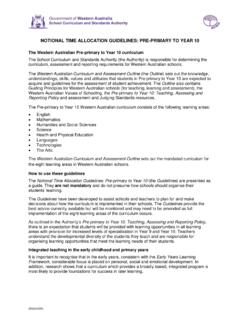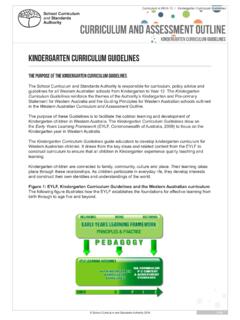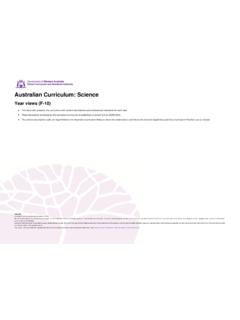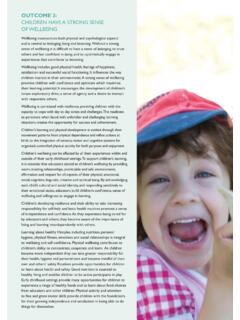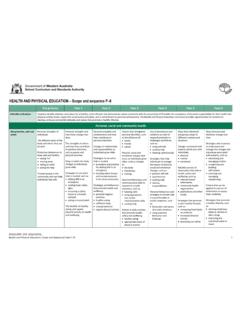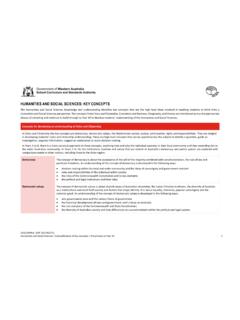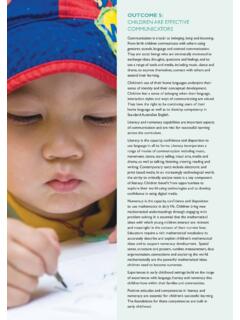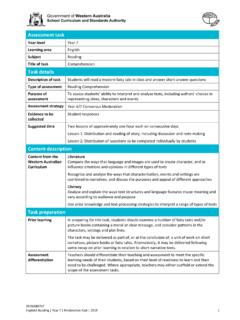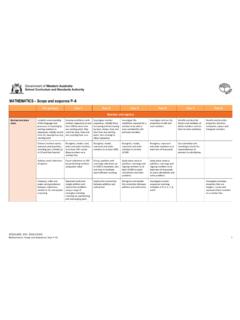Transcription of H SOCIAL SCIENCES - k10outline
1 HUMANITIES AND SOCIAL SCIENCES . Copyright School curriculum and Standards Authority, 2017. This document apart from any third party copyright material contained in it may be freely copied, or communicated on an intranet, for non-commercial purposes in educational institutions, provided that the School curriculum and Standards Authority is acknowledged as the copyright owner, and that the Authority's moral rights are not infringed. Copying or communication for any other purpose can be done only within the terms of the Copyright Act 1968 or with prior written permission of the School curriculum and Standards Authority. Copying or communication of any third party copyright material can be done only within the terms of the Copyright Act 1968 or with permission of the copyright owners. Any content in this document that has been derived from the Australian curriculum may be used under the terms of the Creative Commons Attribution International (CC BY) licence.
2 Humanities and SOCIAL SCIENCES curriculum Pre-Primary to Year 10. 2017/9382 [PDF 2017/9390] Page 2. CONTENT. Rationale .. 4. Aims .. 5. Organisation .. 6. Student diversity .. 10. Students with disability .. 10. English as an additional language or dialect .. 10. Gifted and talented students .. 11. Ways of teaching .. 12. Ways of assessing .. 15. General capabilities .. 17. Cross- curriculum priorities .. 19. Aboriginal and Torres Strait Islander histories and cultures .. 19. Asia and Australia's engagement with Asia .. 19. Sustainability .. 19. Glossary .. 20. Humanities and SOCIAL SCIENCES Pre-primary to Year 6 scope and sequence .. 38. Humanities and SOCIAL SCIENCES Year 7 to Year 10 scope and 46. Pre-primary Humanities and SOCIAL SCIENCES Syllabus .. 53. Year 1 Humanities and SOCIAL SCIENCES Syllabus.
3 56. Year 2 Humanities and SOCIAL SCIENCES Syllabus .. 59. Year 3 Humanities and SOCIAL SCIENCES Syllabus .. 62. Year 4 Humanities and SOCIAL SCIENCES Syllabus .. 66. Year 5 Humanities and SOCIAL SCIENCES Syllabus .. 70. Year 6 Humanities and SOCIAL SCIENCES Syllabus .. 75. Year 7 Humanities and SOCIAL SCIENCES Syllabus .. 79. Year 8 Humanities and SOCIAL SCIENCES Syllabus .. 85. Year 9 Humanities and SOCIAL SCIENCES Syllabus .. 91. Year 10 Humanities and SOCIAL SCIENCES Syllabus .. 98. Appendix 1: Humanities and SOCIAL SCIENCES concepts .. 105. Appendix 2: Humanities and SOCIAL SCIENCES skills .. 114. Humanities and SOCIAL SCIENCES curriculum Pre-Primary to Year 10. 2017/9382 Page 3. RATIONALE. Humanities and SOCIAL SCIENCES is the study of human behaviour and interaction in SOCIAL , cultural, environmental, economic and political contexts.
4 Humanities and SOCIAL SCIENCES has a historical and contemporary focus, from personal to global contexts, and considers opportunities and challenges for the future. In the Western Australian curriculum , the Humanities and SOCIAL SCIENCES learning area comprises four subjects: Civics and Citizenship, Economics and Business, Geography and History. By studying Humanities and SOCIAL SCIENCES , students will develop the ability to question; think critically; make decisions based on evidence; devise proposals for actions; and communicate effectively. Thinking about, reflecting on, and responding to issues requires an understanding of the key historical, geographical, political, legal, economic, business and societal factors involved, and how these different factors interrelate. The Humanities and SOCIAL SCIENCES subjects provide students with the knowledge and skills they need to develop a broad understanding of the world in which we live and how people can participate as active and informed citizens in the 21st century.
5 Humanities and SOCIAL SCIENCES curriculum Pre-Primary to Year 10. 2017/9382 Page 4. AIMS. Develop in students: a deep knowledge and sense of wonder, curiosity and respect for places, people, cultures, events, ideas and environments throughout the world a lifelong sense of belonging to, and engagement with, civic life, with the capacity and willingness to be informed, responsible, ethical and active participants in society at a local, national and global scale a knowledge, understanding and an appreciation of the past and the forces that shape society the ability to think critically, solve problems, make informed decisions and propose actions in relation to real-world events and issues enterprising behaviours and capabilities that enable them to be active participants and decision-makers in matters affecting them, which can be transferred into life, work and business opportunities an understanding of.
6 And commitment to, the concepts of sustainability to bring about equity and SOCIAL justice a knowledge and understanding of the connections among the peoples of Asia, Australia and the rest of the world. Humanities and SOCIAL SCIENCES curriculum Pre-Primary to Year 10. 2017/9382 Page 5. ORGANISATION. CONTENT STRUCTURE. The Humanities and SOCIAL SCIENCES learning area comprises four subjects. Each subject is organised into two interrelated strands: knowledge and understandings and humanities and SOCIAL SCIENCES skills . History and Geography commence in Pre-primary. Civics and Citizenship is introduced in Year 3 and Economics and Business in Year 5. All subjects continue through to Year 10. KNOWLEDGE AND UNDERSTANDING. Humanities and SOCIAL SCIENCES knowledge refers to the facts, principles, concepts, theories and models as developed in each of the subjects.
7 This knowledge is dynamic and its interpretation can be contested, with opinions and conclusions supported by evidence and logical argument. The key concepts are the high-level ideas involved in teaching students to think from a Humanities and SOCIAL SCIENCES perspective. Figure 1 identifies the key concepts for the learning area. Humanities and SOCIAL SCIENCES understanding is the ability to see relationships between aspects of knowledge and construct explanatory frameworks to illustrate these relationships. It is also the ability to apply this knowledge to new situations or to solve new problems. HUMANITIES AND SOCIAL SCIENCES skills . This strand includes a range of skills that are common to all four subjects. These skills can be taught discretely or as part of an inquiry approach. Inquiry is not necessarily implemented in a linear fashion and not all investigations will involve all skills .
8 Moreover, there may be different entry points where the skills are employed as part of an inquiry process. Figure 2 illustrates the Humanities and SOCIAL SCIENCES skills . RELATIONSHIP BETWEEN THE STRANDS. The two strands are to be integrated in the development of a teaching and learning program. The knowledge and understanding strand provides the content focus through which particular skills are to be developed. Following Pre-primary, the sequencing and description of the skills are in two-year bands (1 2, 3 4, 5 6, 7 8, 9 10). This may assist in multi-age programming by providing a common skill focus for the teaching and learning of the knowledge and understanding content. YEAR LEVEL DESCRIPTIONS. Year level descriptions provide an overview of the key concepts addressed, along with core content being studied at that year level.
9 They also emphasise the interrelated nature of the two strands and the expectation that planning will involve integration of content from across the strands. Humanities and SOCIAL SCIENCES curriculum Pre-Primary to Year 10. 2017/9382 Page 6. CONTENT DESCRIPTIONS. Content descriptions set out the knowledge, understanding and skills that teachers are expected to teach and students are expected to learn. They do not prescribe approaches to teaching. The core content has been written to ensure that learning is appropriately ordered and that unnecessary repetition is avoided. However, a concept or skill introduced at one year level may be revisited, strengthened and extended at later year levels as needed. Additional content descriptions are available for teachers to incorporate in their teaching programs.
10 Schools will determine the inclusion of additional content, taking into account learning area time allocation and school priorities. The additional content will not be reflected in the Achievement Standard. OVERVIEWS. In History, the overview content in Years 7 to 10 identifies important features of the historical period. The overview is not intended to be taught in depth. ACHIEVEMENT STANDARDS. From Pre-primary to Year 10, achievement standards indicate the quality of learning that students should typically demonstrate by a particular point in their schooling. An achievement standard describes the quality of learning ( the depth of conceptual understanding and the sophistication of skills ) that would indicate the student is well-placed to commence the learning required at the next level of achievement.
